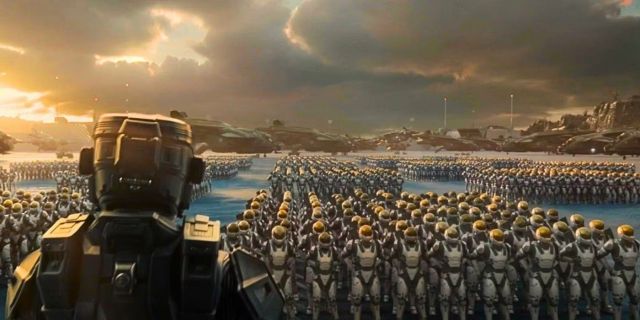The Spartans of the Halo universe are among fiction’s favorite super soldiers. Decked out in iconic armor and wielding well-designed weapons, the Spartans’ polished visor is the face of the Halo franchise. The Spartans underwent several iterations, though the second attempt is the most notable. The latter half of the Halo show’s second season depicts the gradual introduction of the Spartan-III program. The series outlines the third iteration’s ups and downs.
The Halo show has an unusual relationship with the source material. It has dozens of books and several games to pull from, but its new timeline allows the writers to pick and choose. Their Silver Timeline irritated some fans, but the second season borrows more liberally from existing media. That’s been a double-edged sword, as every new decision can stand on its own, and every direct adaptation risks stricter scrutiny.
What are the Spartan-IIIs in the Halo books and games?
The Spartan-III program is the United Nations Space Command’s Office of Naval Intelligence’s third attempt to create biologically augmented super soldiers. The Spartan initiative began in 2231 but ended abruptly after their scientific marvels failed to produce impressive results. The authorities reignited that early effort 175 years later to quell and violently exterminate colonists living on other planets for rising against the Earth-bound government. 165 Special Forces volunteers underwent augmentation and indoctrination to exterminate human insurrectionists silently. They succeeded, but the process proved too costly to justify the results. As the Insurrection grew, partially motivated by accurate conspiracy theories surrounding super soldier programs, the ONI’s Sector 3 scientist Catherine Halsey devised a new scheme. Halsey kidnapped hundreds of children, replaced them with short-lived clones so as not to alert their families, and subjected them to augmentation and indoctrination to create the Spartan-IIs.
The Spartan-IIs immediately became the most effective military system in human history. Outfitted with mechanized armor and advanced weapons systems, each Spartan-II could kill millions of unhappy citizens. Shortly after Halsey released the Spartan-IIs, the Human-Covenant War broke out, providing a better battlefield for her soldiers. There were downsides, however. At least 56% of Spartan-II candidates died or suffered catastrophic disfigurement during the augmentation process. The program was expensive and consistently slowed by specific age requirements. The few who knew about the project considered it a moral abomination, prompting them to seek other methods. There weren’t enough Spartan IIs to win the Human-Covenant War. ONI Colonel James Ackerson developed the Spartan-III program to solve those problems.
Instead of stealing children, the Spartan-III program carefully collected orphans who lost their parents in Covenant attacks. This new recruiting strategy allowed the ONI to create over 1,000 Spartan-III soldiers, led by only 30 Spartan IIs. Ackerson and the ONI planned to mass-produce cheap super soldiers to overwhelm their Covenant enemies with sheer numbers. The new augmentation system also enjoyed a near-0% casualty rate. Some Spartan-IIIs wore Mjolnir power armor but generally used weaker SPI suits. Many of their activities were suicide missions with 100% mortality rates. Though an improvement from stealing and breaking kids, the ONI’s new protocol involved enhancing war orphans to send hundreds to their certain deaths. The Spartan IIIs won several decisive battles, usually through mass sacrifice. The populace attributed many of their accomplishments to the Spartan-IIs for propaganda purposes. Notable Spartan-IIIs include NOBLE Team from Halo: Reach or Veta Lopis’ Ferret Team from Halo: Last Light. Kurt Ambrose offered this quote about Spartan-IIIs:
You know as well as I do that we wind up with some that she would have chosen – not just kids unlucky enough to survive a glassing. Orders are still being followed and those Spartans are in the field, but they are armed as SPARTANs – and they are making a difference.
What are the Spartan-IIIs in the Halo show?
Halo season two borrows significantly from Ghosts of Onyx. The show’s Silver Timeline shifts events considerably. The Spartan-IIIs emerge after the Fall of Reach. They were a pet project of James Ackerson’s while Catherine Halsey remained in captivity. Ackerson and Margaret Parangosky wield the memory of the Master Chief to inspire new soldiers. They don’t mention the recruitment process or augmentation, instead focusing on the training simulations operated by Spartan-II Kai-125. Talia Perez, a communications officer introduced in the season two premiere, becomes a Spartan-III, suggesting they might be pulling inexperienced soldiers for suicide missions.
The show struggles somewhat with the moral issue of sending thousands to die. The season’s penultimate episode reveals that the Spartan-III’s first quest is a Kamikaze strike that will kill every soldier regardless of their success. This motivates Kai to betray Ackerson’s orders and work to save them. It’s a far less nuanced take on the Spartan-IIIs that could emerge into something more engaging in later seasons.
The Spartan-IIIs begin their quests as expendable fodder for a seemingly unwinnable war, but many find camaraderie and victory through righteous anger and endless determination. Many Spartan-IIIs survived the Human-Covenant War, supplementing the more egalitarian Spartan-IV program and forging the Spartan Operations branch of the UNSC. Though most Spartan-IIIs sacrifice everything for their species, some carry their fire beyond the wildest expectations of their cruel creators.











Leave a Reply